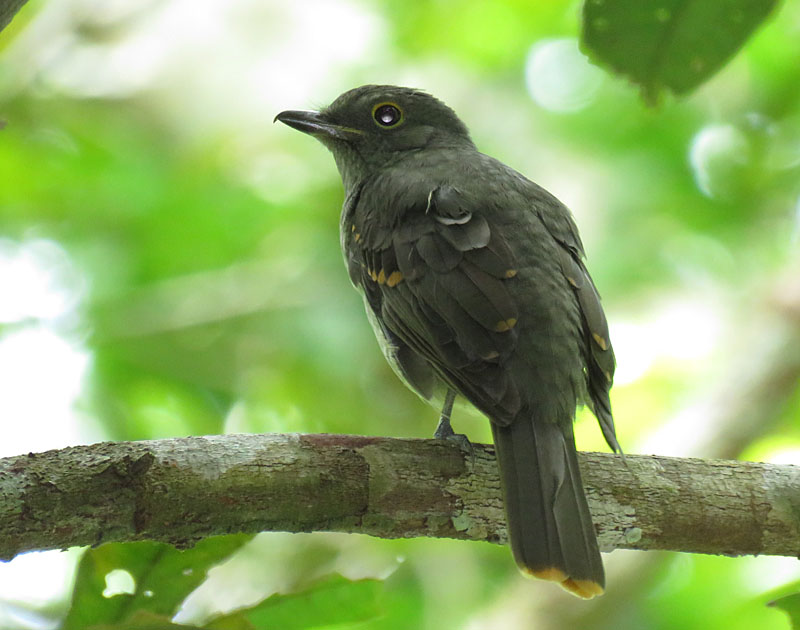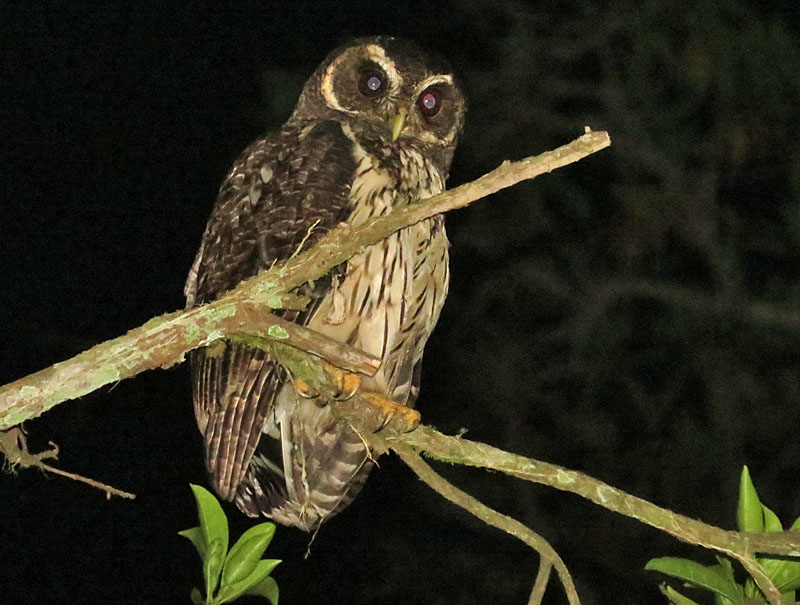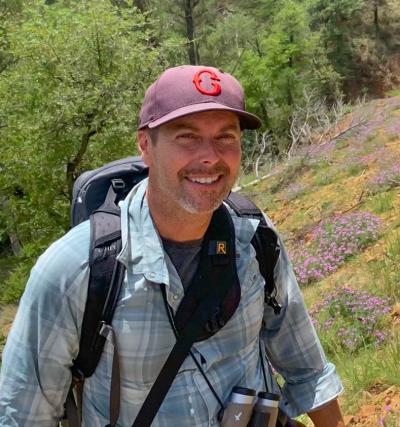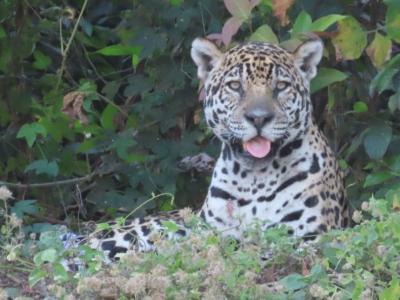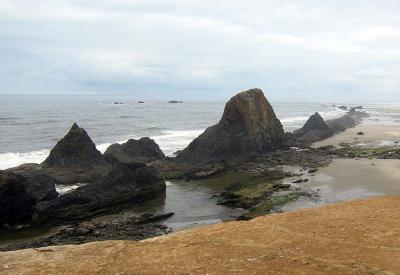2024 Narrative
On our recent tour to the Rainforest Lodges Southeast Peru, we had a great, engaging group of participants with a thirst for knowledge and sharp eyes looking in all directions. We missed very little, and highlights were numerous as we visited two lodges on the Madre de Dios River. One highlight was merely the travel between the lodges on the river, where we got to see the tropical exuberance drift by at a relaxed speed, allowing us to spot some nifty birds, including a couple large roosts of Sand-colored Nighthawk. An audible companion on every ride, as well as along nearly every trail, was the Undulated Tinamou, and we even got to see a family on the grounds of Los Amigos. Hearing the evocative song of Common Potoo from our rooms at Tambo Blanquillo lodge will be a lasting memory, as was the sight of hundreds of parrots and macaws coming to the famous Blanquillo claylick; spying the stunning, stand-out Orange-cheeked Parrots was particularly memorable. Another frequent companion throughout the tour, the Silver-beaked Tanager with its impossibly deep, velvety redhead made it one of the most attractive birds of the tour. In addition to the approximately 360 species of birds we tallied, we saw nine species of monkey, many beautiful butterflies, and if you went to the UV-lit sheet at night, countless moths, beetles, mantises, and more.
It was a very hot and smoky afternoon in Puerto Maldonado at the start of the tour, but after all that city and airport time, we were ready for some birding, even before our official intro meeting and dinner. It was surprisingly birdy the last couple hours of daylight on the outskirts of town; not long after getting out of the van, we found ourselves looking at a pair of adorable White-throated Jacamars. Black-tailed Trogons then took away our attention, and then we worked to get good views of the “adorable if not gorgeous” Rusty-fronted Tody-Flycatcher. A pair of Yellow-crowned Tyrannulets came in surprisingly fast to a simple whistled imitation of their two-note call. At the bottom of the hill, we were quite surprised to find Purus Jacamars perched on powerlines, far from their typical habitat of stunted oxbow edge vegetation. The birds seemed to come nonstop, and we finally declared victory when a Little Cuckoo peered out of a dark hole in a dense shrub that became clearly visible only when viewed through the scope.
A travel day – an hour by car and at least five hours by boat – doesn’t mean no birding. In fact, the leisurely pace of the upriver boat trip meant we were constantly spotting things, from egrets and herons to migrant shorebirds and raptors overhead. Samuel piloted us expertly through the many partially submerged trees, and when he did hit one he quickly replaced the rotor. Early on a pair of Orinoco Geese was a great find, and we knew we were in the tropics when a pair of Blue-and-yellow Macaws flew over. While scanning for shorebirds, we spied several migrants, but a Buff-breasted Sandpiper was the biggest surprise, as most continue to the Bolivia savannas as their favored stopover spot. A resident pair of Collared Plover with babies might have been the cutest thing we saw on the entire tour. Picking out a King Vulture from the more common vultures took skill and patience. We arrived at Los Amigos in time for lunch, settled into our rooms, and then headed out in the afternoon heatwave for the shady forest. We found the ideal spot to sit out the rest of the daylight when we found a pair of Yellow-billed Nunbirds (the scarcest of the trio of species) and watched and listened as four species of woodcreeper appeared.
Like most mornings at Los Amigos, we began at the river overlook where you never know what might appear. This first morning was maybe the busiest though, with a big group of Russet-backed Oropendolas, several Bare-necked Fruitcrows, and a pair of Crimson-crested Woodpeckers all keeping us on our toes, but Scarlet Macaws flying by in perfect light was quite a sight. We eventually wandered down the trails into the old growth terra firme forest, where highlights were a White-throated Tinamou that walked across the trail just as everyone was looking, a pair of scarce Rio Madeira Antwrens, and a beautiful Waved Woodpecker. In the afternoon we took a walk down into the varzea forest on the lower level. We only understood how lucky we were to find the regional specialty Black-faced Cotinga by the end of the tour, as this would be our only one. Another highlight here was a Black-faced Antthrush that walked under a boardwalk and across the trail, but the most amazing sighting was of the Ocelot. As we were watching a troop of monkeys, we heard what sounded like the wings of a larger bird suddenly flapping away into the canopy and then glimpsed something dropping a few meters down the ground. For a few seconds there was no sign of anything, and we weren’t sure what to think. Then some of us had a glimpse of something walking under the boardwalk, and Tom said, “It’s a feline!” There, peering at us 20 meters away at the curve of the boardwalk was the face of an Ocelot. It was there just long enough for everyone to get on it, but not for photos before it slinked off into the rainforest understory. Our best guess was that it had leapt for and just missed catching a Spix’s Guan. In the evening we walked around a bit after dinner and had visuals of the resident Tawny-bellied Screech-Owl and several Common Pauraques around the clearing.
On our second full day we spent the morning mostly in bamboo, seeing several of that habitat’s specialties. One of the tour highlights came early when a pair of spectacular Rufous-headed Woodpeckers came in. This was the first time we’ve had this rare and local bird on this tour. A pair of White-browed Antbirds briefly joined one mixed flock we encountered, but we noticed they had other things in mind when we saw the male carrying a leaf and then passed on to the female. Before turning back for lunch, we added a few more bamboo specialists, such as Striated Antbird and Yellow-breasted Warbling-Antbird, but the very confiding and rather rare Long-crested Pygmy-Tyrant was the best find. After lunch we walked to the palm swamp where birding was relatively quiet, though we continued to pick up some nice finds. A pair of Rufous Motmots appeared at the start of the steps down to the swamp, while a very close Gray Tinamou sang its distinctive one-note song nearby. As we came back to the top of the steps, we surprised a group of Pale-winged Trumpeters; fortunately, they came back into the trail for those still climbing the steps, and we had great views of this special rainforest understory crane, the only ones we would see on the tour.
Our third day saw us spend all morning in the seasonally flooded varzea, though it was almost entirely dry this time of year. Mixed flock activity was good on the way out, and we picked up Spot-winged Antshrike, Long-billed Woodcreeper with its crazy bill, beautiful Bluish-fronted Jacamars looking like giant hummingbirds, giant Red-necked Woodpeckers, and a very close and appropriately named Varzea Schiffornis. We heard a Dull-capped Attila, an evocative song that recalls nothing of our temperate homes. With a long hike back for lunch, we took it easy in the afternoon to explore around the lodge on our own. That gave us the energy for an owling walk after dinner, which was highly productive. We were a bit alarmed as the Giant Toads kept getting larger and larger as we walked down the trail, but they finally peaked at simply enormous and only slightly smaller than a cow. Our first Crested Owl was rather unresponsive, but once in the deeper tall forest we found a pair of Black-banded Owls, and with little effort called in a Crested Owl. On the way back we had a gorgeous Black-necked Amazonian Coralsnake in the trail and a surprise Band-tailed Manakin on a roost right over the trail.
We returned to the varzea on our fourth morning, but for a shorter walk that featured our first Dwarf Tyrant-Manakin at close range, followed by a stop in a Band-tailed Manakin lek, where we also found a pair of Black-capped Becards. A little mixed flock contained an adorable Ruddy-tailed Flycatcher and both species of spadebills. A furtive pair of Ivory-billed Aracaris seemed to disappear at first, but then they reappeared over the trail and instantly became one of the day’s highlights. On the way back we got even better views of the White-crested Spadebill when we found a very young juvenile begging incessantly from a perch right over the trail. In the afternoon we stayed up in the terra firme, reaching an overlook of an old bend of the Los Amigos River. On the way we had group of very inquisitive Purple-throated Fruitcrows, while at the overlook a pair of Black-faced Antbirds came in very close from the thickets below. We came across a small understory flock on the way back, and in it was a family of Gray Antwrens, and the very young, begging juvenile sat still for extended views with the spotting scope.
The long-awaited cold front finally came, and our final day’s temperatures were shockingly comfortable. In the morning there was little sign of the night’s violent wind or rain (just a very occasional drop from the sky), but the overcast and cool weather kept the morning mixed flock activity low. At the overlook there seemed to be more parrots than usual, and big flocks of gorgeous Blue-and-yellow Macaws were notable. We birded the bamboo and tall canopy edge near the old airstrip, and here we found White-lined Antbird in the understory and saw a Western Striolated-Puffbird (the “Obama-bird”) whistling its plaintive song from a tall tree. A re-visit of the Mauritia flexuosa palm swamp resulted in just a brief sighting and finally at least a call response from a Sungrebe. Birding really picked up in the sunny but still relatively cool afternoon, with a Crested Caracara soaring past, and flocks that included Masked Tanager and Paradise Tanager in the fruiting melastomes and cecropias near the bench overlook. We visited again the clearing that is the future site of new cabins, finding a trio of White-throated Jacamars, two female Yellow-rumped Caciques just barely starting their nests (while being serenaded by a seemingly self-absorbed and unhelpful male). A pair of Chestnut-headed Crakes were deafening but invisible as ghosts in the dense understory a short way down the trail.
We had a bit of the morning at Los Amigos, where a very busy mixed flock nearly delayed our departure. Chestnut-shouldered Antwren, White-winged Shrike-Tanager, and a rare Yellow-crested Tanager were the highlights, but we departed on time for what would be a slower than usual boat ride due to the very low water level of the river; this time Samuel had the help of Dider as a spotter for the deeper channels. The muddied waters, gravel tailing piles, and ever-present litter from the increasing gold mining in the region gave way to the relatively pristine and clean upper Madre de Dios once we passed the mouth of the Rio Colorado, the river that carries all the ore downstream from the Andean foothills. We had a few more delightful hours on the river after this, seeing many Black Skimmers and their recently fledged chicks, rare migrant Wilson’s Phalaropes stopping over at an unusually low elevation, spritely White-winged Swallows, three Burrowing Owls, and many Sand-colored Nighthawks foraging during the day (presumably the cool post-cold front weather had kept them hungry).
Our first morning at Tambo Blanquillo was all about the parrots. We stayed long enough at the blind to see the numbers of Red-and-green Macaws come to nibble on the dirt, but we were not bored waiting for them. The fancy Orange-cheeked Parrots among the mind-blowing numbers of Blue-headed Parrots was a highlight, and by carefully sifting through the many Tui Parakeets we got good views of a pair of Amazonian Parrotlets, a rare bird that’s very easy to miss. There were more than just parrots at the blind, as two Slate-colored Hawks and nearly 50 other species of birds entertained us. Birding our way on foot back to the lodge included Hoatzins sharing perches with Purus Jacamars and a family of noisy Red-throated Caracaras not far off the trail. Our late afternoon activity was a delightful paddle around Cocha Camungo, where Pale-eyed Blackbird and Black-capped Donacobius were among the many wonderful birds we saw, but the real highlight was the family of Giant Otters that ignored us at first and then when we ignored them came right up to the boats, snorting away.
We began our final day at Tambo Blanquillo with another paddle, this time on Cocha Blanco. We heard very well and some of us even got good glimpses of Rufous-sided and Gray-breasted Crakes, but the real surprise were the two Least Bitterns that flushed from the marsh, a very scarce bird in these parts. We saw many Pale-vented Pigeons, and in the perfect early morning sunlight we could see how incredibly colorful they were. After the boat ride, mixed flock activity along trail included a pair of Pink-throated Becards that appeared to be carrying nesting material. An afternoon atop the canopy platform in the magnificent kapok tree by Cocha Camungo gave us an amazing view of the forest below, and from there we saw White-rumped Syristes, a nest of a Plumbeous Kites just a few yards away at eye level, and a Dusky-capped Flycatcher to remind us of home. The many species of stingless bees in countless numbers got the better of us, and we descended the platform before our time was up, but that gave us some time to bird on the way back to the lodge. A very distantly singing Rufous-capped Antthrush seemed like wishful thinking, but with a tiny bit of playback, like magic the bird flew in silently and perched in plain sight on a nearby log. Then some activity on young river island led to an impromptu stop where we flushed a few Sand-colored Nighthawks right near the shore; not part of the big and impressive roost just downstream, these birds may have been nesting. We avoided the gravel where there may have been eggs and enjoyed watching the nearby Burrowing Owl and were surprised by a pair of River Tyrannulets, probably present in this young vegetation on similar islands everywhere along the river, but rarely reported from the region.
Early morning birding down a trail from our lodge resulted in great views of a pair of Ochre-throated Foliage-gleaners and our best views yet of the Buff-throated Woodcreeper, which we had heard almost daily. A pair of Streaked Flycatchers were probably building a nest behind our cabins as we finally caught up on some hummingbirds at the Stachytarpheta hedge, including a Rufous-breasted Hermit that was suspiciously carrying spider web to an unseen location. The boat trip downstream to Boca Colorado went by rather quickly, but we still managed some daily highlights, including migrant Wilson’s Phalaropes (same ones from a couple days earlier?) and a surprise Upland Sandpiper, another migrant that usually passes over Peru on its way to open grasslands farther south. An Opal-crowned Tanager and a Chestnut-bellied Seed-Finch were minor consolation prizes from an hour hold-up due to road construction, and once on the paved Interoceanic Highway to Puerto Maldonado, we made just one quick stop for a lovely Capped Heron in a roadside puddle.
A new birding site only a half hour from our hotel seemed promising, and we ended up wishing we had a few more hours to bird the rice fields of Bello Horizonte. We soon spotted the local Maguari Stork that had been reported for a few weeks, but we also discovered that there were three of them, all wanderers from Bolivia. A Rufescent Tiger-Heron with rodent in its bill soon was sated for the day. A Gray-cowled Wood-Rail wandered along the edge of one rice field while we searched among the many shorebirds, ibises, and herons to find the rare Yellowish Pipits. A big flock of Double-collared Seedeaters seemed to be the perfect place to look for something unusual, and we lucked into a male Lined Seedeater with them. One last parting bird was a soaring White-tailed Hawk, though back at our hotel we padded the list with last-second additions of Purple-throated Euphonia and Plain Tyrannulet. Soon we were back in Lima, where a farewell dinner had us looking forward to our return to Peru.
Back to Narratives
















